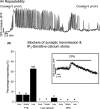Acute cocaine exposure elicits rises in calcium in arousal-related laterodorsal tegmental neurons
- PMID: 28596834
- PMCID: PMC5461641
- DOI: 10.1002/prp2.282
Acute cocaine exposure elicits rises in calcium in arousal-related laterodorsal tegmental neurons
Abstract
Cocaine has strong reinforcing properties, which underlie its high addiction potential. Reinforcement of use of addictive drugs is associated with rises in dopamine (DA) in mesoaccumbal circuitry. Excitatory afferent input to mesoaccumbal circuitry sources from the laterodorsal tegmental nucleus (LDT). Chronic, systemic cocaine exposure has been shown to have cellular effects on LDT cells, but acute actions of local application have never been demonstrated. Using calcium imaging, we show that acute application of cocaine to mouse brain slices induces calcium spiking in cells of the LDT. Spiking was attenuated by tetrodotoxin (TTX) and low calcium solutions, and abolished by prior exhaustion of intracellular calcium stores. Further, DA receptor antagonists reduced these transients, whereas DA induced rises with similar spiking kinetics. Amphetamine, which also results in elevated levels of synaptic DA, but via a different pharmacological action than cocaine, induced calcium spiking with similar profiles. Although large differences in spiking were not noted in an animal model associated with a heightened proclivity of acquiring addiction-related behavior, the prenatal nicotine exposed mouse (PNE), subtle differences in cocaine's effect on calcium spiking were noted, indicative of a reduction in action of cocaine in the LDT associated with exposure to nicotine during gestation. When taken together, our data indicate that acute actions of cocaine do include effects on LDT cells. Considering the role of intracellular calcium in cellular excitability, and of the LDT in addiction circuitry, our data suggest that cocaine effects in this nucleus may contribute to the high addiction potential of this drug.
Keywords: Arousal; REM sleep; cholinergic; in vitro; mouse.
Figures




Similar articles
-
Electrophysiological changes in laterodorsal tegmental neurons associated with prenatal nicotine exposure: implications for heightened susceptibility to addict to drugs of abuse.J Dev Orig Health Dis. 2015 Jun;6(3):182-200. doi: 10.1017/S204017441400049X. Epub 2014 Oct 23. J Dev Orig Health Dis. 2015. PMID: 25339425
-
The appetite-inducing peptide, ghrelin, induces intracellular store-mediated rises in calcium in addiction and arousal-related laterodorsal tegmental neurons in mouse brain slices.Peptides. 2015 Mar;65:34-45. doi: 10.1016/j.peptides.2015.01.006. Epub 2015 Jan 30. Peptides. 2015. PMID: 25645492
-
Prenatal nicotine is associated with reduced AMPA and NMDA receptor-mediated rises in calcium within the laterodorsal tegmentum: a pontine nucleus involved in addiction processes.J Dev Orig Health Dis. 2015 Jun;6(3):225-41. doi: 10.1017/S2040174414000439. Epub 2014 Nov 3. J Dev Orig Health Dis. 2015. PMID: 25362989
-
The contribution of neuroplasticity induced in cholinergic neurons of the laterodorsal tegmental nucleus to cocaine addiction.Nihon Shinkei Seishin Yakurigaku Zasshi. 2017 Feb;37(1):1-7. Nihon Shinkei Seishin Yakurigaku Zasshi. 2017. PMID: 30452815 Review. English, Japanese.
-
The role of neuroplasticity in cholinergic neurons of the laterodorsal tegmental nucleus for cocaine addiction.Nihon Arukoru Yakubutsu Igakkai Zasshi. 2016 Oct;51(5):259-67. Nihon Arukoru Yakubutsu Igakkai Zasshi. 2016. PMID: 30478016 Review. English, Japanese.
Cited by
-
CaCO3-encircled hollow CuS nanovehicles to suppress cervical cancer through enhanced calcium overload-triggered mitochondria damage.Asian J Pharm Sci. 2024 Dec;19(6):100989. doi: 10.1016/j.ajps.2024.100989. Epub 2024 Nov 2. Asian J Pharm Sci. 2024. PMID: 39640053 Free PMC article.
-
Plasticity in the Brainstem: Prenatal and Postnatal Experience Can Alter Laterodorsal Tegmental (LDT) Structure and Function.Front Synaptic Neurosci. 2020 Feb 7;12:3. doi: 10.3389/fnsyn.2020.00003. eCollection 2020. Front Synaptic Neurosci. 2020. PMID: 32116639 Free PMC article.
References
-
- Abreu‐Villaca Y, Seidler FJ, Slotkin TA (2004a). Does prenatal nicotine exposure sensitize the brain to nicotine‐induced neurotoxicity in adolescence? Neuropsychopharmacology 29: 1440–1450. - PubMed
-
- Abreu‐Villaca Y, Seidler FJ, Tate CA, Cousins MM, Slotkin TA (2004b). Prenatal nicotine exposure alters the response to nicotine administration in adolescence: effects on cholinergic systems during exposure and withdrawal. Neuropsychopharmacology 29: 879–890. - PubMed
-
- Baghdoyan HA, Rodrigo‐Angulo ML, McCarley RW, Hobson JA (1984). Site‐specific enhancement and suppression of desynchronized sleep signs following cholinergic stimulation of three brainstem regions. Brain Res 306: 39–52. - PubMed
LinkOut - more resources
Full Text Sources
Other Literature Sources

